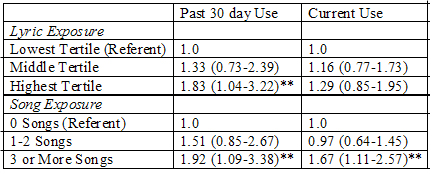Many researchers suspect that exposure to public health toxins, such as gambling, alcohol, and tobacco, can lead to changes in engagement with those toxins (LaPlante & Shaffer, 2007; Shaffer, LaBrie, & LaPlante, 2004). Consistent with this perspective, many studies have examined the health effects of toxin-related imagery in movies, music, literature, and the like (Addiction and the Humanities, Vol. 6(3); 3(2); and 1(11). This week, for Addiction and the Humanities we review a study that examined the association between adolescents’ exposure to cannabis in popular music, and their cannabis use (Primack et al., 2009).
Methods
- The researchers examined the baseline survey data of an anti-smoking clinical trial involving all students (N=959; 80% of those eligible) enrolled in 9th grade health classes at three large Pittsburgh, PA high schools.
- The baseline survey included socio-demographic, parenting style, sensation seeking, rebelliousness, and alcohol-use scales and variables.
- The study estimated students’ cannabis lyric exposure in two ways:
- First, by asking students the number of hours per day they listen to music and their favorite musician. The researchers used this information, in combination with the results of a separate content analysis of musicians’ songs (Primack, et al., 2008), to determine each student’s unique exposure to cannabis lyrics (i.e., the product of students’ hours per week listening to music by the number of cannabis references per hour in their favorite artist’s songs).
- The researchers categorized students’ exposure scores into tertiles: low, medium, and high.
- Second, by determining students’ favorite artist’s number of songs that contained cannabis lyrics (i.e., 0 songs, 1-2 songs, or 3 or more songs with cannabis lyrics).
- The primary outcome variables of interest were: (1) ever cannabis use, even a puff (yes or no) and (2) past 30 day cannabis use, even a puff (yes or no).
Table 1: Odds Ratios (95% Confidence Intervals) for Cannabis Use/Exposure Relationship

**p<.05; multivariate regression analyses controlling for all covariates (i.e., socio-demographic, parenting style, sensation seeking, and rebelliousness scales and variables)
Results
- As displayed in Table 1, multivariate logistic regressions, controlling for all covariates (i.e., socio-demographic, parenting style, sensation seeking, and rebelliousness scales and variables), showed that compared to those with the lowest exposure to cannabis lyrics, those with the highest exposure had higher odds of past 30 day cannabis use.
- Regression analyses also showed that compared to those with the lowest song exposure, those with the highest exposure had higher odds of past 30 day cannabis use and ever cannabis use.
Limitations
- The study relied on self-reported data without corroboration; therefore, this study is subject to the problems commonly associated with self-report.
- The study does not consider the role of individual resiliency factors (e.g., positive social networks), which might influence exposure processes.
- The measures of exposure assume that students’ favorite artist also is their most played artist, which might not be the case.
- The study design is cross-sectional; therefore, it cannot establish whether the cannabis exposure and engagement relationship is causal.
Discussion
The study supports research that suggests that exposure to specific public health toxins is associated with increased engagement with those toxins. It is the first study to illustrate this phenomenon with cannabis, using exposure estimation calculations. Future research in the area might consider the role of resiliency factors, which might change the nature and shape of the relationship between exposure and engagement. Also, research on exposure effects for other public health toxins suggests that exposure effects often are attenuated over time, through adaptation processes (LaPlante & Shaffer, 2007; Shaffer et al., 2004). Researchers and others should consider whether such processes might apply here, and/or how to facilitate such processes and minimize prototypical exposure effects.
-Debi LaPlante
What do you think? Please use the comment link below to provide feedback on this article.
References
LaPlante, DA & Shaffer, H. J. (2007). Understanding the influence of gambling opportunities: Expanding exposure models to include adaptation. American Journal of Orthopsychiatry, 77, 616-623.
Primack, B. A., Dalton, M.A., Carroll, M. V. Agarwal., A. A. Fine, M. J. Content analysis of tobacco, alcohol and other drugs in popular music. Archives of Pediatric Adolescent Medicine, 162, 169-175.
Primack, B. A., Douglas, E. L., & Kraemer, K. L. (2009). Exposure to cannabis in popular music and cannabis use among adolescents. Addiction, 105, 515-523.
Shaffer, H.J., LaBrie, R.A., LaPlante, D.A. (2004). Laying the foundation for quantifying regional exposure to social phenomena: Considering the case of legalized gambling as a public health toxin. Psychology of Addictive Behaviors, 18(1), 40–48.




